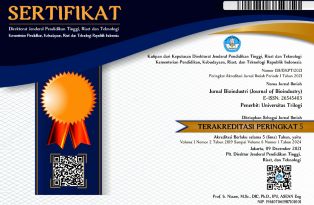ANALYSIS OF SPECIES COMPOSITION AND DISTRIBUTION PATTERN OF WEEDS IN CABBAGE (Brassica oleracea L.) IN SENDURO DISTRICT LUMAJANG REGENCY
Abstract
Cabbage is an annual vegetable crop. The presence of weeds in cabbage plants can reduce productivity. Weed composition is a weed community that grows in a field. The purpose of this study was to determine the composition of weeds and dominant weeds in cabbage cultivation. The method used is the point intercept method, namely by determining 9 plots on 2 cabbage cultivation lands. Data were analyzed qualitatively and descriptively. The variables observed included relative frequency, relative dominance, summed dominance ratio (SDR), and weed community coefficient (C). The results showed that the highest relative frequency value in land A namely Persicaria nepalensis was 23,68%, while in land B namely Drymaria cordata L. was 21.95%. The highest relative dominance value was in land A namely Persicaria nepalensis which was 29.06%, while in land B namely Drymaria cordata L. which was 31.45%. The highest SDR value was in land A namely Persicaria nepalensis which was 26.37%, while in land B namely Drymaria cordata L. which was 26.70%. The C value in land A and land B is 74.43%, and the weed community in land A and land B is not significantly different. Analysis of the composition of weed species in cabbage land between A and land there is a difference.
Keywords
Full Text:
PDFDOI: https://doi.org/10.31326/jbio.v6i1.1689
Refbacks
- There are currently no refbacks.
Editorial Office:
Fakultas Bioindustri
Universitas Trilogi
Jl. TMP Kalibata No.1
Jakarta 12760
Copyright Notice:


2.png)






2.png)







